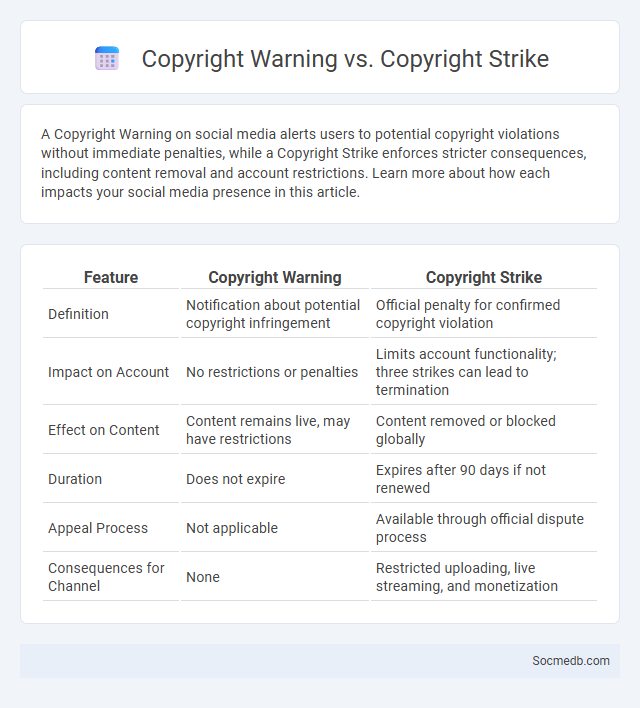
Photo illustration: Copyright Warning vs Copyright Strike
A Copyright Warning on social media alerts users to potential copyright violations without immediate penalties, while a Copyright Strike enforces stricter consequences, including content removal and account restrictions. Learn more about how each impacts your social media presence in this article.
Table of Comparison
| Feature | Copyright Warning | Copyright Strike |
|---|---|---|
| Definition | Notification about potential copyright infringement | Official penalty for confirmed copyright violation |
| Impact on Account | No restrictions or penalties | Limits account functionality; three strikes can lead to termination |
| Effect on Content | Content remains live, may have restrictions | Content removed or blocked globally |
| Duration | Does not expire | Expires after 90 days if not renewed |
| Appeal Process | Not applicable | Available through official dispute process |
| Consequences for Channel | None | Restricted uploading, live streaming, and monetization |
Understanding Copyright in the Digital Age
Understanding copyright in the digital age is crucial as social media platforms facilitate rapid sharing and reproduction of content, increasing the risk of copyright infringement. Users must recognize the importance of respecting intellectual property rights by obtaining proper permissions before using or distributing copyrighted material online. Awareness of digital copyright laws helps protect creators' original works while fostering a responsible and legally compliant social media environment.
What is a Copyright Warning?
A copyright warning is a formal notification indicating that your social media content potentially infringes on copyrighted material. This alert is issued to protect intellectual property rights and prevent unauthorized use of videos, images, music, or text. Understanding and responding promptly to a copyright warning helps you avoid legal consequences and maintain your account's integrity.
What is a Copyright Strike?
A copyright strike occurs when your social media content violates intellectual property laws by using copyrighted material without permission or proper licensing. Platforms like YouTube, Facebook, and Instagram enforce copyright strikes to protect creators' rights, often resulting in content removal, account restrictions, or even suspension. Understanding how copyright strikes work on your chosen social media platform helps you avoid penalties and maintain your account's good standing.
Key Differences Between Copyright Warning and Copyright Strike
A copyright warning on social media alerts users about potential intellectual property violations without immediate penalties, allowing opportunities for content removal or modification. A copyright strike, however, is a formal action that can result in account restrictions, content takedown, or suspension after repeated infringements. Platforms like YouTube enforce strikes more stringently, impacting user privileges and channel monetization.
How Platforms Issue Copyright Warnings
Social media platforms monitor content using automated detection systems that identify copyrighted material through digital fingerprinting and content recognition algorithms. When copyright infringement is detected, you typically receive a warning notification outlining the violation and potential consequences, including content removal or account suspension. Platforms also provide mechanisms for rights holders to submit takedown requests, ensuring enforcement aligns with copyright law.
The Impact of Receiving a Copyright Strike
Receiving a copyright strike on social media can severely limit your account's functionality, including restrictions on posting, live streaming, and monetization opportunities. Your content visibility may be reduced, and repeated strikes could lead to permanent account suspension. Understanding the platform's copyright policies helps you protect your digital presence and avoid losing valuable followers and revenue.
Consequences of Multiple Copyright Strikes
Multiple copyright strikes on social media platforms can lead to severe account restrictions, including temporary suspension or permanent deletion. These strikes damage a content creator's reputation and reduce audience reach due to limited visibility in algorithms. Platforms like YouTube and Instagram enforce strict copyright policies to protect original creators and prevent repeated violations.
How to Respond to a Copyright Warning
When receiving a copyright warning on social media platforms like Facebook or Instagram, promptly review the accused content and verify ownership claims through tools such as YouTube's Content ID or Facebook Rights Manager. To respond effectively, submit a counter-notification if you believe your content falls under fair use or if you hold proper licensing rights, ensuring compliance with the platform's copyright policies. Maintaining detailed records of permissions or licenses can expedite resolution and prevent future copyright disputes.
Steps to Take After Receiving a Copyright Strike
Upon receiving a copyright strike on social media platforms like YouTube or Instagram, review the infringement details thoroughly to understand the claim's validity. File a counter-notification if you believe the strike is wrongful, ensuring to provide compelling evidence to support your case. Monitor your account status closely during the dispute process to prevent further restrictions or potential account termination.
Best Practices to Avoid Copyright Issues
To avoid copyright issues on social media, always ensure you have permission or proper licensing before sharing content created by others, including images, videos, and music. Use original content or royalty-free resources from reputable platforms to maintain compliance with copyright laws. Properly attribute sources when required and regularly review platform guidelines to stay updated on copyright policies.
 socmedb.com
socmedb.com